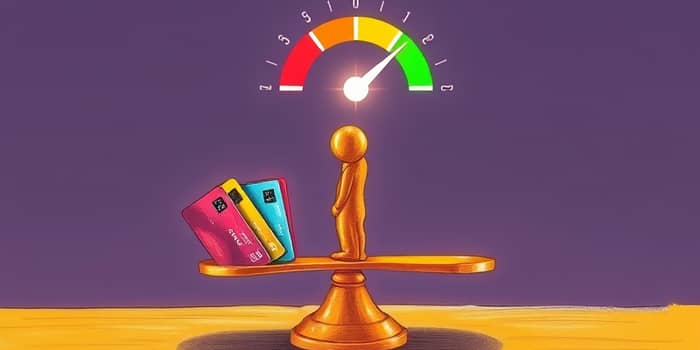
Credit utilization plays a pivotal role in shaping your creditworthiness and overall credit score. Understanding how to manage this ratio effectively can unlock powerful benefits, from lower interest rates to improved financial opportunities. In this article, we explore the essentials, deliver actionable strategies, and clarify common misconceptions to help you achieve and maintain a high credit score.
The credit utilization ratio measures the percentage of your available revolving credit that you are currently using. It focuses exclusively on revolving accounts like credit cards and lines of credit, excluding installment loans such as mortgages or auto loans. To calculate this ratio, divide your combined credit card balances by your total credit limits and multiply by 100.
For example, if you have a total credit limit of 10000 and a combined balance of 2500, your credit utilization rate is 25. This metric is reported both at the individual account level and as an overall utilization rate across all revolving accounts, and lenders evaluate both to assess risk.
Credit utilization accounts for a significant portion of most scoring models. In the FICO scoring system, it makes up 30% of your FICO Score, second only to payment history. VantageScore models also incorporate this metric and, in newer versions, examine utilization patterns over time. A high ratio signals potential overextension and elevates default risk, while a low utilization ratio demonstrates responsible credit management.
Lenders scrutinize utilization to gauge whether you rely heavily on borrowed funds. Maintaining a healthy balance between usage and capacity can directly influence autopay decisions, loan approvals, and interest rates. By staying alert to this key indicator, you position yourself as a low-risk borrower.
Industry experts and credit bureaus generally advise keeping your overall credit utilization below 30. For even stronger performance, aim for below 10% for optimal performance. Below is a simple breakdown of utilization brackets and their typical interpretations:
While zero utilization indicates no reliance on credit, occasional low-level usage underscores active, responsible credit management and can contribute positively to your score trajectory.
Understanding both per-card and overall utilization is essential. Even if your aggregate ratio is low, maxing out a single card can trigger red flags. Credit scoring models consider both metrics in tandem, so pay attention to each account’s balance relative to its limit.
These figures illustrate how balances and limits interact. Even with a healthy combined ratio, a single high-utilization account can negatively influence your score. Aim for balanced usage across all revolving accounts.
Credit utilization is a dynamic metric that fluctuates with purchases, payments, and statement cycles. Credit reporting agencies capture balances at the time your issuer reports to bureaus, usually on statement closing dates. Lowering your balance before this date can immediately reduce your reported utilization.
Many scoring models, including the latest FICO 10 T and VantageScore 4.0, examine average utilization trends over time. Consistently carrying high balances—even if paid off shortly after—can create a pattern that persists in your credit history, potentially suppressing your score long term.
Implementing targeted strategies can help you maintain an optimal credit utilization ratio and elevate your credit score. Additionally, keep your total available credit plentiful and accessible to maximize your borrowing capacity.
With these actions, you ensure that your utilization remains under control, paving the way for lower interest rates and greater borrowing power.
Several myths surround credit utilization that can mislead borrowers. Clarifying these points helps you make informed decisions and avoid self-sabotaging behaviors.
Visualizing your credit limit as a dinner plate can simplify the concept. The more you fill your plate with food (balances), the less empty space (available credit) remains. Just as a balanced meal leaves room for variety, balanced credit usage leaves breathing room on your accounts, signaling healthy financial habits.
Remember that a plate completely empty (zero usage) suggests you never eat, which might not be optimal. Similarly, occasional, low-level credit use demonstrates that you can manage borrowing responsibly and pay it back on time.
Recent advances in credit scoring have shifted focus from a single snapshot to longitudinal trends. Models like FICO 10 T and VantageScore 4.0 incorporate trended data, rewarding borrowers who manage utilization consistently. This evolution underscores the importance of maintaining low balances not just at month end, but throughout each billing cycle.
By understanding these emerging criteria, you can stay ahead of the curve and adapt your credit habits to meet the expectations of modern scoring algorithms.
Mastering credit utilization is a foundational step in achieving and sustaining a high credit score. By monitoring your ratios, employing strategic payment habits, and leveraging available credit responsibly, you place yourself in a position of strength. Embrace these guidelines to unlock improved loan terms, competitive interest rates, and the confidence that comes from solid financial stewardship.
Your journey toward exceptional credit begins with disciplined, informed action. Keep your utilization low, stay vigilant about reporting dates, and watch your score flourish as a testament to your financial resilience.
References













